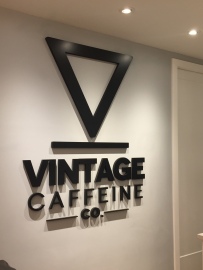
Last night my daughter and I went to Vintage to learn about Latte Art. It was a very intimate event, only five people, Bina (the owner) and Isabella (the teacher). We started off by a little learning session about the difference in coffee beans, robusta and arabica. The robusta beans have a very woody earthy taste to them because they are produced at a lower altitude, whereas the arabica beans have a fruity citrusy taste to them because they are produced at a higher altitude.
After that we started to learn how to extract the espresso and how to properly steam the milk. Bina showed us the correct way of levelling the espresso before you tamp. You want to tap the sides of the porta filter on the sides and then set it down with your body beside the porta filter and the have your elbow at a 90 degree bend and push the tamp down of the espresso to compress.
We found out that every time Vintage switches to a new bean they adjust the grind time and the drip time from the espresso.
Before we started playing with steaming milk, we started with water and a drop of soap. We were told that starting with water we could get the motion of steaming it, and how to properly pour in a cup. Isabella showed us the technique of pouring the water, how to hold pitcher, and how to move your wrist to get those beautiful designs in the cups. Once Bina and Isabella believed that we all had the skills, we got to move onto the milk. The video is showing us how to properly steam the milk.
Bina and Isabella got the cups ready with an espresso shot in the bottom, then it was up to us. We poured the right amount of milk into the pitcher and then steamed it. We were looking for a velvety smooth consistency to the milk, that means little to no bubbles after steaming. Once that was complete we pour a little into the espresso to get the right Caramel colour, then pour the steamed milk with the cup at a comfortable angle, when you pour the milk you want to aim for the corner of the cup (where the side connects to the bottom). That way your design is more central in the cup then off to one side. The video is showing us how to create a heart in your latte.
The first one my daughter did was not that great but mine was good, it actually looked like a heart. We found it really helpful that both Bina and Isabella were watching over commenting to help you make your design better and help you pour the right way.
The second round my daughters was not good at all, she didn’t let enough air in milk so she didn’t have enough to make a design, so it was a frothy mess. My second one had a design in it which kinda looked like a blobby heart. The video is me pouring my latte art.

Isabella and Bina realized we were having a few issues with how we were pouring the milk into the cups, either we were pouring too fast or not fast enough. Bina decided we should go back to the water and soap for a couple times to make sure our technique was correct. Bina wanted to check our speed of our pour so that the last few times we went to milk our designs would look amazing.
The third round my daughter got lucky and actually pulled off a design that resembled a heart and mine resembled an acorn. I felt like we were getting better and better. Clearly practice makes you better. My daughter recorded me when I was creating my latte art.
Our last round, my daughter had some major skills and made a latte fish, it was a blob heart and then Isabella pulled out a stick and made it into a fish. My final latte looked like a hologram heart balloon. I really believe that we managed to get better.
Everyone thinks that this is a simple skill, but I now know that there is a lot of skill and practice that goes into a nicely designed latte art. There is a lot of work to be able to master this skill.
My daughter and I would like to thank Bina and Isabella for all of their knowledge and skills that they taught us.








Leave a comment